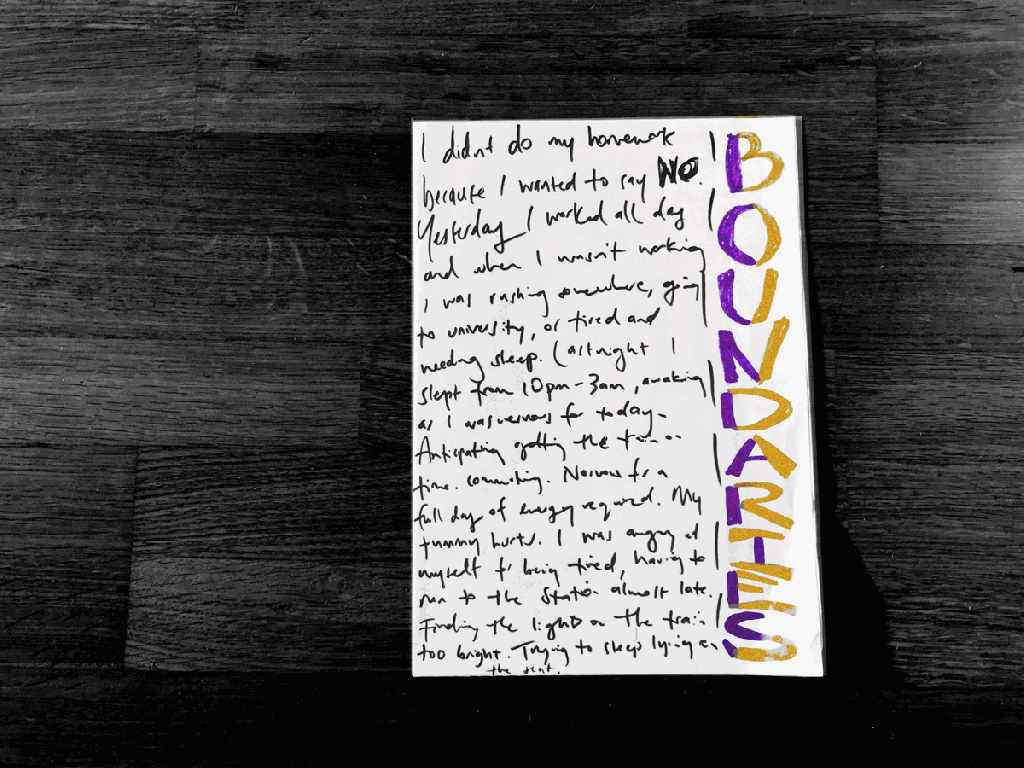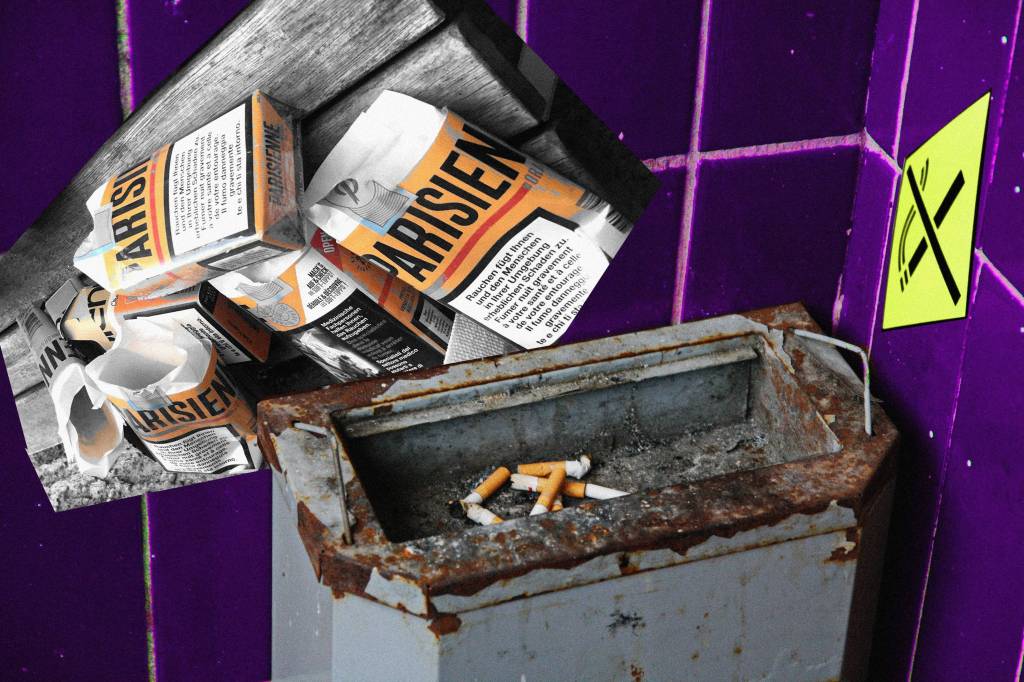The story of the concept for the work MENTAL HELLTH DUMPSTER FIRE begins in the Living Museum Ateliers that are part of Psychiatry St. Gallen’s grounds in Wil, Switzerland.
Arranged by Zurich University of the Arts’ (ZHdK) ‘Artists in Labs’ programme, I spent a semester in residency at Switzerland’s Living Museum Ateliers under the guidance of Dr. Nicole Ottiger for the purpose of artistic research, including practice-based, on burnout and exhaustion. The first Living Museum was established in the early 1980’s in Queens, New York City by Janos Marton, a Hungarian artist and psychologist, and Bolek Greczynski, an artist from Poland. Their concept lays at the intersection of psychiatry, mental health, and artistic production, offering workspaces and guidance for those experiencing mental health issues that is,
[…] dedicated to the beauty of art and healing. The aim is to change identity from the mentally ill to the artist in an atmosphere of community, solidarity and creativity.
The Living Museum as an artistic concept is based on a performance in which everything is changing and in perpetual transformation. Both the members and the artworks are growing. Individual characteristics that make you an outsider in society are celebrated in the Living Museum and offer an advantage in the creation of art.
The high artistic potential of people who have had extreme psychological experiences is appreciated and shown to the public in exhibitions. The Living Museum reverses the prevailing idea of integration: not the mentally ill should reintegrate themselves into society, but society should integrate itself into the Living Museum and be healed from there.[1]
After spending time in Living Museum New York as part of her PhD, Dr. paed. Rose Ehemann brought the concept back to Switzerland and initiated the Living Museum Ateliers in Wil to work under the same philosophy, which opened in 2002. The Living Museum Ateliers in Switzerland, Wil, is the only one in the country and is part of the province’s (St. Gallen) public health system, situated on the grounds of a 130 year old psychiatric clinic – St.Gallen Nord Psychiatric Clinic (PSGN) – that is massive and full of green space, dozens of building for various purposes (including in-patient care), stables with donkeys, a horticulture area growing plants, fruit, and vegetables, which can be bought onsite at a little shop.
In the Swiss Living Museum location, one experiences the intended ‘liveliness’ of a place of art production and exhibition. Beyond offering four different studios across three floors (ceramic studio, glass/wood studio, paper and digital studio, and the largest on the ground floor—art and media, which includes painting, sculpture, textile, music and theatre) the Living Museum is also open to the public and has its ‘heart’ in the form of a central café where visitors and artists co-exist. Artists-in-residence can be invited, like myself, to work alongside the artists who are there via various diagnosis-related reasons.

Psychatric Clinic Wil, St. Gallen North, Switzerland.
Inside the Living Museum Ateliers
To enter the Living Museum is to experience the said liveliness. There is always something going on, the art and artistry visible is remarkable. Imaginative, striking, unforgettable. During my time there what stood out was how the artists are referred to as just that, artists, The label of patient is left at the door. Diagnoses are not spoken about on the floor, and immediately feel irrelevant. Some of the artists are inpatients, though most are outpatients. Apparently 100 artists come through and work there on a daily basis. They run the café and restock a ‘free wardrobe’ (a rack of giveaway clothing, shoes, and accessories.) No matter what material you might be looking for, or technique or practice you would like to learn, there is always somebody around to help. During my residency I was placed with Dr. Ottiger in the so-called Paper Atelier, where people come to draw, paint, do origami and make other paper crafts, or use the computers to do digital work, print their musical scores for the music studio below — amongst many other practices. Every studio has a range of working places, some more separate, solitudinal and quiet, others more group-oriented or central. At the Living Museum all personal preferences are welcome and accommodated. Below is an excerpt from a text I wrote during this period that gives an impression of the atmosphere and experience of spending time in such an environment, depicting the spontaneous socialities that arise during smoking breaks.

A text written during the residency on DEEP HANGING OUT as an artistic research environment
and the spontaneous socialites of smoking.
Boundaries: A Starting Point
The project I worked on whilst at the Living Museum began with the theme of boundaries. Boundaries is a key word that came up again and again in my conversations and discussions with people on the topic of burnout throughout the successive years of research. Essentially, one learns that the setting of boundaries (in all aspects of life) and learning how to assert and protect them becomes uncompromisable, reaching non-negotiable. Taking this to Wil as my starting point, I had also been thinking about the voicing of boundaries. How hard it can be to do so, how great it would be to communicate them without needing to do that verbally, thus avoiding the inherent labour that comes drawing these lines, making that heard, upholding or defending them. Sharing these thoughts with Dr. Ottiger, I told her how some days I wish I had the words ‘NOT TODAY’ emblazoned across my front (not literally like a slogan t-shirt, just a disclaimer, a permiation whether visible or sensed otherwise.) We discussed the embodiment of these feelings, and the way that clothes are a sort of boundary upon the body. A barrier between ourselves and the world. A simultaneous means of expression.

Nicole asked me what I had studied before the Master in Transdisciplinary studies at Zurich University of the Arts, and I replied that I had done my bachelor’s in textile technology, development, and garment production, in Amsterdam. At that stage I was also customising clothing in my free time, returning to my teenagehood of making homemade band tees and patches for the music I loved the most. Combining these insights with her knowledge of my Band of Burnouts research lab, she suggested to why not start making band patches again during the residency. Having departed from my textile-based practices, and later work in the fashion industry, long ago – never did I expect to be back with it in 2023, let alone accepting this as a good idea. Something within me liked Nicole’s proposition, I wasn’t opposed to it. I got excited about it. And so, returning to working with textiles is precisely what I did. Later I would find out that this is part of her process with inbound patients: Meet them where they’re at. Find out what they like, what they know. Have them start with what’s familiar. I had been successfully therapised without noticing it.

Each day at the clinic, I would chat with my fellow workmates in the morning and ask about how they were feeling and what they would like to express to the world that day. This became the practice; listening to their sharings, noting down their anecdotes and wishes (as well as my own) and creating band merch-style patches from them that could be worn on the body. Each one had its own materialisation, own styles, colours, graphics, shapes and sizes, always experimenting with application and formal techniques, scavenging for scraps and unexpected materials around the building. We would take turns wearing them, enjoying the reactions and provocations the patches produced. Once I had made a lot, we had a resource to pick from depending on how we felt that morning. The joke became ‘Hmmm, so how do I want to tell the world to fuck off today?’

These would later become the work MENTAL HELLTH DUMPSTER FIRE.
If my peers had time or weren’t working on their own project at that moment, other hands helped and made their own. Some were taken home, others stayed with me. The variations in processes, materials, and aesthetics were vast—just like our personalities and stories—from melted plastic letters glued onto leather, to ceramic squares with words written onto them with markers. The results were personal and varied but somehow retained a universal quality. We were all in this building for different, though ultimately similar, reasons. At the Living Museum people dealing with psychiatric disorders, addiction, burnout, depression, and anxiety, amongst a breadth of other things, all come together under the same roof for the common intent of artistic practice and making art. I was in a difficult period with my own mental and physical health, particularly the worst bout of insomia I’ve ever experienced, as well as a trying phase in my personal life, and felt as much benefit therapy-wise and blending in with the others as I did as researcher and artist resident. These walls certainly broke down and in retrospective were highly integrative (even though I still stuck out like a sore thumb being a non-German speaking girl from New Zealand who somehow ended up in a psychiatric clinic in Wil. That was clearly found to be exotic and random.) No matter where we were coming from or what had brought us there, there was one thing that everybody I was working with voiced in common: Feeling exhausted.

Whether tired from not sleeping, stressed by the national, semi-privatised health system or social stigmas, fatigued from overwork, being drained by a busy mind or trying to juggle children with health issues, the overarching theme that pervaded was “Coping with this is tiring. Please give me space, I’m feeling burnt out.” The theme was not isolated to the clinical experience, and it wasn’t only being felt but those entangled with illness and the national health system. All my years of listening to anecdotes and feelings of burnout (whether the term was being used colloquially, referring to a diagnosis, or about the condition present yet undiagnosed) and the months in the Living Museum were beginning to collide with conversations with friends over dinners and their recounting of stories of talks with their own friends, family, colleagues, community and people. One line a fellow artist said to me over drinks in early 2023 summarised the general social ambiance; ‘Nobody is doing alright.’

Digital collage using own and found imagery and applied treatments.
One line a fellow artist said to me over drinks in early 2023 summarised the general social ambiance; ‘Nobody is doing alright.’
This piece is continued in a part II on how this residency led to the work MENTAL HELLTH DUMPSTER FIRE, a multimedia piece including textile works, zines, and texts, as a cultural commentary on how burnout may have become more than an individual condition, but a social mood. Part II will be online next week. Stay tuned.
[1] “About – Living Museum Society.” Living Museum Society. Last modified May 19, 2023. https://living-museum.com/about/